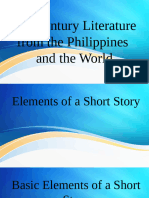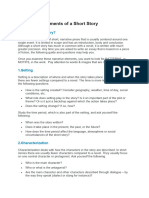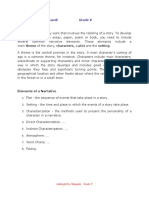0 ratings0% found this document useful (0 votes)
18 viewsLesson 7
21st Century Literature Lesson 7
Uploaded by
Ian Caesar TagubaCopyright
© © All Rights Reserved
Available Formats
Download as PPTX, PDF, TXT or read online on Scribd
0 ratings0% found this document useful (0 votes)
18 viewsLesson 7
21st Century Literature Lesson 7
Uploaded by
Ian Caesar TagubaCopyright
© © All Rights Reserved
Available Formats
Download as PPTX, PDF, TXT or read online on Scribd
You are on page 1/ 32
21ST CENTURY
LITERATURE FROM THE
PHILIPPINES AND THE
WORLD
Objectives:
At the end of the lesson, you are
1.demonstrate
expected to: understanding of a
short story;
2.analyze a short story by
identifying its basic elements.
Basic Elements
of a Short Story
1.
A character in a short
Character
story is a person, in some
stories an animal, who
takes part in the action of
the story or other literary
work.
Two Most Important
Characters in a Short
Story
PROTAGONIST ANTAGONIS
T
Protagonist
Considered as the main character or most important of
all the characters.
It is the character who learns something or undergoes
some changes throughout the course of the story.
Some stories depict the protagonist as the hero of the
story, while in other stories the protagonist is not
considered a hero as he has done nothing heroic. In any
case, the story always revolves around the protagonist.
Antagonist
It is the character that challenges the main
character.
It has no concern for the well-being of the
main character.
The antagonist may be a person, the
nature, the society, or any intangible matter
that contends with or creates a problem for
2. Setting
It is the place
(locale) and time
(period )when the
story happens.
3. Plot
A plot is the actual
story. It is what the
story is all about.
Different
Parts of a
Story’s
Structure
a.
This is the beginning of the story. This
Expositio
is where the author introduces the
n
characters, identifies where the story
is happening, and establishes the
main conflict.
b. Rising
ThisAction
event occurs as you begin to
move throughout the story. This
is where conflicts start to build.
c. Climax
It is the most exciting part of a
short story. This is the part in the
story when important decisions
are made or important things are
discovered.
d. Falling
This point occurs after the climax as the
Action
problems in the story start to work
themselves out. The excitement
becomes less and less as the conflict is
resolved.
e.
This is the solution to the problem in a
Resolution
story. The solution may not be what you
hoped for but as long as it fits the story
in tone and theme, the conflict has
been resolved.
4. Conflict
Every story needs to
have a problem and
this problem is called
conflict.
Conflict
• The main character, also
called the protagonist, needs
to have someone or
something to challenge him.
• Without conflict, the story will
not go anywhere and will not
Four Types of
Conflict
Man versus man
Man versus nature
Man versus himself
Man versus society
5. Theme
This is the
central idea in a
short story and a
general truth.
6. Point of
View
This is the way the story
is told or narrated. It is
also known as the
vantage point that a
writer uses to narrate the
Types of Point of
View
FIRST PERSON
The narrator participates in and
tells the story using the
pronoun ‘I’.
Types of Point of
LIMITED View
THIRD
• The narrator is not in the story and narrates
using thePERSON
pronouns ‘she’ or ‘he’.
• Also, the narrator is unable to see into the minds
of the characters.
Types of Point of
View
OMNISCIENT THIRD
• The narrator is not in the story and tells the story
PERSON
using the pronouns ‘she’ or ‘he’.
• In this point of view, the narrator can tell the
thoughts of the characters as he can see into their
minds.
Activity:
Create an adaptation of the
short story “Sinigang” using six-
word flash fiction. Upload it on
your Facebook account using
#SinigangShortStory
#21stcenturyliterature
Thank
you!
DIRECTIONS: In this activity, you have to identify the plot structure of the story “Sinigang”. Write A for
exposition; B for rising action; C for climax; D for falling action; and E for resolution. Write your
answers on a separate sheet of paper.
1. “Did you meet…her?” Tita Loleng asked.
2. The woman looked to me like she was in her forties—the same age as my mother.
3. The woman, upon seeing my curious stare, had explained, “I am Sylvia.”
4. I finally turned to him. There was only one question I needed to ask. “Why?”
5. I wanted to scream at her to let go but I did not move away.
6. All my muscles tensed upon hearing her name. It took all my self-control to outwardly remain calm
and simply raise an eyebrow.
7. When my Dad had come out of the room, I remembered sensing it immediately— the same way
an animal instinctively perceives when it is in danger.
8. When her weeping had subsided, she raised her head and looked at me. “Everyone makes
mistakes, Liza.” Her eyes begged for understanding.
9. I continued to pick out tomatoes for the sinigang we were to have for dinner. I wasn’t usually the
one who assisted my aunt with the cooking.
10. “I’m sorry,” he had told me.
DIRECTIONS: Study the following questions carefully
and write your answers on a separate sheet of paper.
1. Where did the story happen ?
2. Who were the characters in the story?
3. What do you think led to the emotional separation
of Liza from her father?
4. What was the most interesting part of the story?
5. What was the story about?
6. Who narrated the story?
Activity
ACROSS
1. a purpose of anecdote where sharing frightening stories of dangers
can be helpful for them to realize the possible consequences of their
actions
4. It contains series of pictures or pages of information (slides) arranged
in sequence and often displayed on a large screen using a video
projector.
6. an anecdote usually conveys success in life.
7. it is a short entertaining or interesting story about a real incident or
person.
8. an electronic device used to record, copy, playback, broadcast, and
display moving visual media.
DOWN
2. is a visual, stylized arrangement of words or tags within a textual
content such as websites, articles, speeches and databases.
3. a purpose of anecdote where people are talking about their
experiences in the past.
You might also like
- Take Off Your Pants! Outline Your Books For Faster, Better Writing-Notebook0% (1)Take Off Your Pants! Outline Your Books For Faster, Better Writing-Notebook10 pages
- Creative Writing: Reported By: Llana Venice P. Tablo & MembersNo ratings yetCreative Writing: Reported By: Llana Venice P. Tablo & Members30 pages
- Creative Writing: Reported By: Llana Venice P. Tablo & MembersNo ratings yetCreative Writing: Reported By: Llana Venice P. Tablo & Members49 pages
- 21st Century M5 Elements of Short StoryNo ratings yet21st Century M5 Elements of Short Story20 pages
- Creative Writing 2 Elements, Techniques, and Literary Devices inNo ratings yetCreative Writing 2 Elements, Techniques, and Literary Devices in24 pages
- EDITED 21st Century Lit Q1 Module 5 Elements of Short Story 08082020No ratings yetEDITED 21st Century Lit Q1 Module 5 Elements of Short Story 0808202023 pages
- Bell Ringer Define The Following Terms in Your JournalNo ratings yetBell Ringer Define The Following Terms in Your Journal100 pages
- ENGLISH-6-LAS-Q3-WEEK5-AQUINO-MICHAEL-CAMPOS-ELUMBA-FUGOSO-PEDRALBANo ratings yetENGLISH-6-LAS-Q3-WEEK5-AQUINO-MICHAEL-CAMPOS-ELUMBA-FUGOSO-PEDRALBA8 pages
- Lesson 5 Analysis of Prose Using Elements of A Story and ExamplesNo ratings yetLesson 5 Analysis of Prose Using Elements of A Story and Examples11 pages
- Sinigang: by Marie Aubrey J. VillaceranNo ratings yetSinigang: by Marie Aubrey J. Villaceran25 pages
- Week 4 Topic 1 Elements of A Short StoryNo ratings yetWeek 4 Topic 1 Elements of A Short Story41 pages
- Meeting 1 Creative Writing Praktisi MengajarNo ratings yetMeeting 1 Creative Writing Praktisi Mengajar27 pages
- Elements of Fiction Notes (Highlighted)No ratings yetElements of Fiction Notes (Highlighted)36 pages
- Worksheet 2 - Lights, Camera, Action! The Story of My SuccessNo ratings yetWorksheet 2 - Lights, Camera, Action! The Story of My Success2 pages
- 21st Century Literature From The Philippines and The World: Elements of A Short StoryNo ratings yet21st Century Literature From The Philippines and The World: Elements of A Short Story14 pages
- English 4 Quarter 4-Week 2: MODULE 2: Writing A Reaction About A Character in A Story Read. What I Need To KnowNo ratings yetEnglish 4 Quarter 4-Week 2: MODULE 2: Writing A Reaction About A Character in A Story Read. What I Need To Know5 pages
- Hatchet Plot diagram and conflict definitionsNo ratings yetHatchet Plot diagram and conflict definitions10 pages
- Literary Devices VS Literary TechniquesNo ratings yetLiterary Devices VS Literary Techniques7 pages
- Write Your Fucking Novel: Aqua CreationsNo ratings yetWrite Your Fucking Novel: Aqua Creations100 pages
- Take Off Your Pants! Outline Your Books For Faster, Better Writing-NotebookTake Off Your Pants! Outline Your Books For Faster, Better Writing-Notebook
- Creative Writing: Reported By: Llana Venice P. Tablo & MembersCreative Writing: Reported By: Llana Venice P. Tablo & Members
- Creative Writing: Reported By: Llana Venice P. Tablo & MembersCreative Writing: Reported By: Llana Venice P. Tablo & Members
- Creative Writing 2 Elements, Techniques, and Literary Devices inCreative Writing 2 Elements, Techniques, and Literary Devices in
- EDITED 21st Century Lit Q1 Module 5 Elements of Short Story 08082020EDITED 21st Century Lit Q1 Module 5 Elements of Short Story 08082020
- Bell Ringer Define The Following Terms in Your JournalBell Ringer Define The Following Terms in Your Journal
- ENGLISH-6-LAS-Q3-WEEK5-AQUINO-MICHAEL-CAMPOS-ELUMBA-FUGOSO-PEDRALBAENGLISH-6-LAS-Q3-WEEK5-AQUINO-MICHAEL-CAMPOS-ELUMBA-FUGOSO-PEDRALBA
- Lesson 5 Analysis of Prose Using Elements of A Story and ExamplesLesson 5 Analysis of Prose Using Elements of A Story and Examples
- Creative Writing Guide: Turning You Idea into a StoryFrom EverandCreative Writing Guide: Turning You Idea into a Story
- Worksheet 2 - Lights, Camera, Action! The Story of My SuccessWorksheet 2 - Lights, Camera, Action! The Story of My Success
- 21st Century Literature From The Philippines and The World: Elements of A Short Story21st Century Literature From The Philippines and The World: Elements of A Short Story
- English 4 Quarter 4-Week 2: MODULE 2: Writing A Reaction About A Character in A Story Read. What I Need To KnowEnglish 4 Quarter 4-Week 2: MODULE 2: Writing A Reaction About A Character in A Story Read. What I Need To Know





























































































